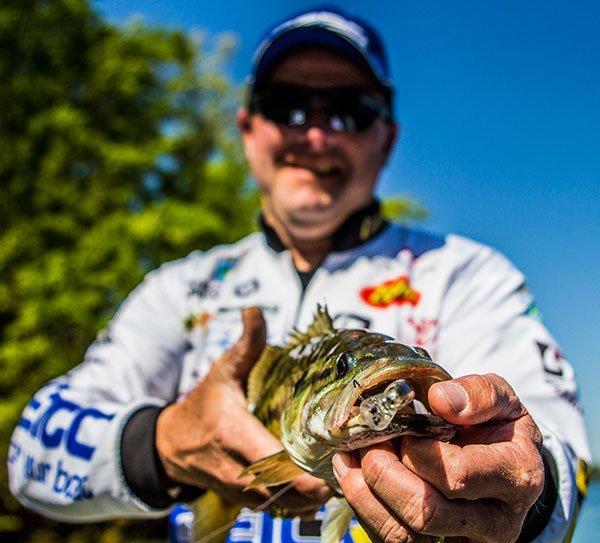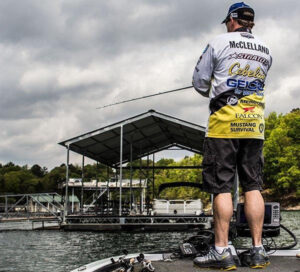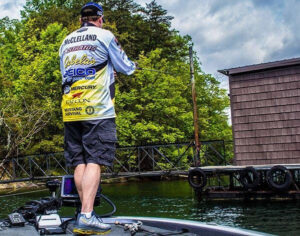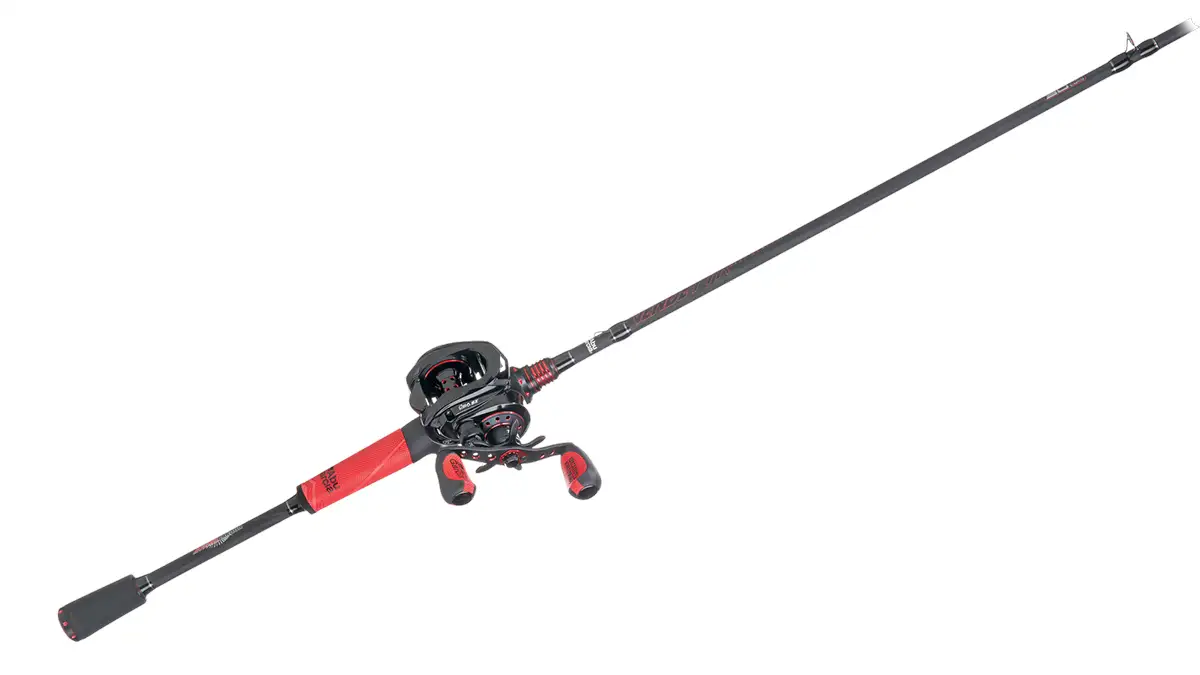When many anglers think of fishing docks, wooden pier docks often come to mind. Floating docks, however, are excellent places to fish throughout the entire spring. As the bass move to and from spawning flats, the abundant shade and feeding opportunities floating docks provide make them ideal staging areas for bass.
If SPRO pro Mike McClelland is targeting floating docks in the spring, you can be sure he’ll have a jerkbaitin his hand. Due to the jerkbait’s ability to cover a multitude of water depths, he’s weighed in numerous big bags with this technique.
The method for floating dock jerking
Throughout spring, bass will flock to floating docks—especially in fisheries void of natural cover. While soft plastics and jigs are the most popular techniques for fishing pier docks, floating docks call for a different approach.
“A jerkbait is just an awesome selection when you’re fishing floating docks,” McClelland said. “Floating docks don’t always offer poles or other cover for the bass to hold tightly to, so they’ll simply suspend under them. Jerkbaits allow you to easily key in on specific depths while also keeping your bait in the most productive strike zones longer.”
Floating docks aren’t always the most appealing type of cover to fish for some anglers. Although they may not be adorned with cross braces, wooden ladders and other known bass holding features, these docks often play host to their own ecosystem.
“The abundance of bass forage floating docks hold for bass is incredible,” McClelland said. “On clear water fisheries, it’s pretty amazing to see how many big bream and shad live under them. The algae that grows on the underside of their floats is a magnet for all kinds of food for bass, and wherever there’s food, bass won’t be far away.”
Prespawners holding close to the floats
The prespawn period on many lakes can be quite finicky at times. As the bass begin moving from deeper water in search of spawning areas, cold water temperatures and slow metabolism can make it difficult to get consistent bites. Floating docks offer a remedy to slow, cold water prespawn fishing.
“Most floating docks have black plastic floats,” McClelland said. “The black plastic warms up quickly and provides more comfortable conditions for prespawn bass. Although it may only make the water temperature a degree or two warmer, the smallest increases in water temperature can play a huge role in prespawn fishing.”
https://s3media.247sports.com/Uploads/wired2fish/2013/05/fishing-floating-dock-with-jerkbait.jpg
When targeting prespawn bass on floating docks, McClelland instinctively reaches for a suspending jerkbait. Because the bass may still be slow to attack a fast moving presentation, he wants to keep his bait in front of the bass until they decide to strike.
“A SPRO McStick 110, 95 and 85 are perfect jerkbaits for this situation,” McClelland said. “Each model allows you to cover all of your depth ranges while giving you 3 different sizes to match the available forage.”
His jerkbait cadence is very slow and deliberate throughout the prespawn. After pulling the McStick down to his desired depth, he follows with 2 short twitches. Following the twitches, it’s somewhat of a waiting game.
“I start out by letting the McStick sit still for 5 seconds,” McClelland said. “After 5 seconds, I’ll twitch it some more and continue to let it sit. If I don’t get any bites, I’ll increase my cadence to a 10-count. You have to be very patient, but it’s worth it.”
Post-spawners and fry guarders in the late spring
As bass finish their annual spawning ritual, they seek refuge under nearby floating docks in order to feed, recuperate and guard newly hatched fry. McClelland utilizes a SPRO McStick 115 to fool these hungry post-spawners.
“The McStick 115 is a great choice for post-spawn bass around floating docks because it only dives to about 3 feet and it also floats,” McClelland said. “Post-spawn fry guarders have a hard time passing on a floating jerkbait, so I always have one tied on.”
Floating marina docks also have a lot to offer for post-spawners. The extensive shade they provide and their strategic locations give bass a perfect opportunity to replenish after a rigorous spawn.
“Marinas are a big key to post-spawn jerkbait fishing,” McClelland said. “On most fisheries we visit, a bunch of bass spawn in the shallow areas behind the marinas, making them convenient post-spawn staging areas. You’ll find a ton of forage, protection for fry and also the occasional shad spawn that big bass will capitalize on. It’s like a big bass dinner buffet.”
McClelland uses a much more aggressive, erratic cadence during the post-spawn. You’ll rarely find him fishing a McStick slowly.
“I’m going to jerk it pretty hard and keep it down in the water column in most situations,” McClelland said. “It’s almost like I’m ‘walking the dog’ with a topwater, except underwater. All I’m trying to do is make the most aggressive bass react to the erratic movement. I’ll jerk it a couple of times, quickly reel up my slack and do it all over again—it’s all about reaction bites.”
The right approach for dock jerkbaits
When fishing jerkbaits around floating docks, McClelland has developed a very methodical approach that continues to pay big dividends for him. Instead of haphazardly casting, he knows exactly where he’s going to cast.
https://s3media.247sports.com/Uploads/wired2fish/2013/05/casting-jerkbait-to-floating-dock.jpg
https://s3media.247sports.com/Uploads/wired2fish/2013/05/casting-jerkbait-to-floating-dock.jpg
“I always approach floating docks in line with the back side,” McClelland said. “I stop about a cast’s length away from the dock, cast to the back corner, swing the boat around and throw down the side of the dock. I’m always careful to cover all of the corners, because they’re a hotspot for big bass.”
Surprisingly, he doesn’t make a concerted effort to get his jerkbait underneath the docks. Because jerkbait fishing is more of a sight technique, the fish will swim a considerable distance to eat it. More times than not, he’s found that getting a jerkbait too close to the bass will actually spook it and decrease his productivity.
Floating docks are also very easy to pattern, according to McClelland. Although there may be an oddball bass that bites in a random place, developing a solid floating dock pattern can be fairly simple.
“Most importantly, you have to figure out whether they want to be tucked into the deep shade or on the edges of the shade,” said McClelland. “The angle of the sun is usually the deciding factor with a floating dock pattern. When the sun is high, bass will tend to be in the deep shade provided by boat slips. In the early morning and late evening, however, I’ve found the shade edges to be most productive.”
Whether you’re fishing for prespawn bass in the north or targeting post-spawners in the south, try fishing floating docks with a jerkbait. With an understanding of the bass’ behavior, an efficient approach and the proper jerkbait, you’re likely to catch a lot of fish with this technique.















